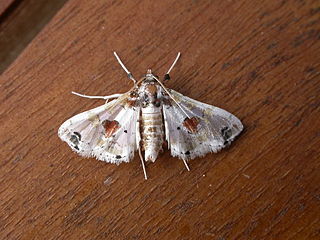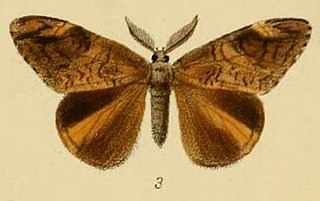Dasyarctia is a monotypic genus of tiger moths in the family Erebidae. The genus includes only one species, Dasyarctia grisea, which is found in South Africa and Tanzania.

Leucinodes is a genus of moths of the family Crambidae. It was first described by Achille Guenée in 1854.

Adisura is a genus of moths of the family Noctuidae. Species are found thoroughout India and Sri Lanka, Africa and some far East Asian countries. Differs from Pyrrhia species in having sparsely spined mid and hind tibia and thorax without sharp crest.
Megalonycta is a genus of moths of the family Noctuidae. The genus was erected by Pierre Viette in 1965.

Plecopterodes is an Afrotropical genus of moths of the family Erebidae.

Aroa is a genus of moths in the subfamily Lymantriinae first described by Francis Walker in 1855. Species are distributed in South Africa, China, throughout India, Sri Lanka, Myanmar, and Java.
Adisura atkinsoni, the field-bean pod borer, is a moth of the family Noctuidae. The species was first described by Frederic Moore in 1881. It is found in Lesotho, KwaZulu-Natal, Transvaal, Zimbabwe, Mozambique, Zambia, Malawi, Congo, Kenya, Uganda and on Madagascar. It is also present in India, China, Korea, Indonesia (Sumatra), Japan, Sri Lanka, Taiwan, Vietnam and the Himalayan region.
Heliothis transvaalica is a species of moth of the family Noctuidae first described by William Lucas Distant in 1902. It is found in Transvaal of South Africa and in Namibia.
Heliocheilus biocularis is a species of moth of the family Noctuidae first described by Max Gaede in 1915. It is found in Africa, including South Africa.
Max Gaede was a German engineer and entomologist of international fame who described several hundred of new species of Lepidoptera, mainly African Noctuidae.

Leucinodes laisalis is a species of moth in the family Crambidae.
Nausinoe reussi is a species of moth of the family Crambidae described by Max Gaede in 1917. It can be found in Tanzania, in eastern Africa.
Glyphodes bitriangulalis is a moth of the family Crambidae described by Max Gaede in 1917. It is found in South Africa (Gauteng), Zimbabwe, and Mali.
Urojana is a monotypic moth genus in the family Eupterotidae first described by Max Gaede in 1915. The only known species of this genus is Urojana eborea, which is known from Ivory Coast.
Paraphyllalia is a monotypic moth genus in the family Eupterotidae described by Max Gaede in 1927. Its single species, Paraphyllalia degenera, was described Its Francis Walker in 1855 and is found in South Africa.



